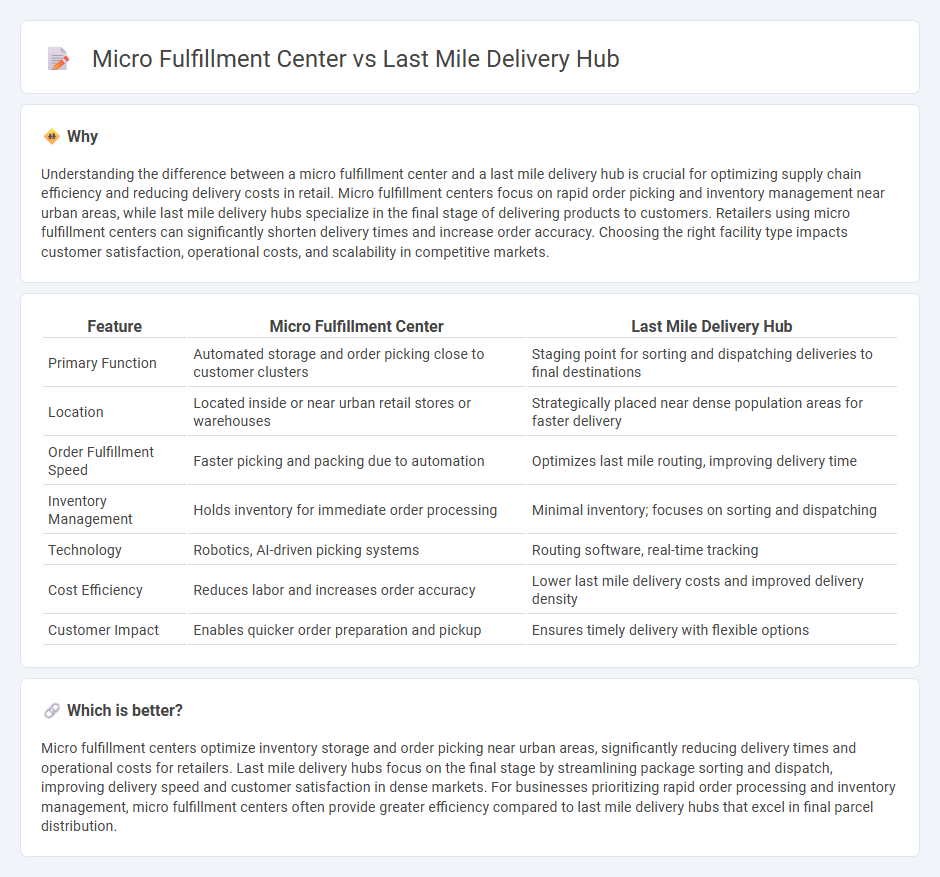
Micro fulfillment centers optimize inventory storage within urban areas, enabling rapid order processing and reduced delivery times for retailers. Last mile delivery hubs serve as centralized locations focused on the efficient dispatch and distribution of goods to final customers, enhancing delivery speed and reliability. Explore the differences and benefits of each facility type to improve your retail logistics strategy.
Why it is important
Understanding the difference between a micro fulfillment center and a last mile delivery hub is crucial for optimizing supply chain efficiency and reducing delivery costs in retail. Micro fulfillment centers focus on rapid order picking and inventory management near urban areas, while last mile delivery hubs specialize in the final stage of delivering products to customers. Retailers using micro fulfillment centers can significantly shorten delivery times and increase order accuracy. Choosing the right facility type impacts customer satisfaction, operational costs, and scalability in competitive markets.
Comparison Table
| Feature | Micro Fulfillment Center | Last Mile Delivery Hub |
|---|---|---|
| Primary Function | Automated storage and order picking close to customer clusters | Staging point for sorting and dispatching deliveries to final destinations |
| Location | Located inside or near urban retail stores or warehouses | Strategically placed near dense population areas for faster delivery |
| Order Fulfillment Speed | Faster picking and packing due to automation | Optimizes last mile routing, improving delivery time |
| Inventory Management | Holds inventory for immediate order processing | Minimal inventory; focuses on sorting and dispatching |
| Technology | Robotics, AI-driven picking systems | Routing software, real-time tracking |
| Cost Efficiency | Reduces labor and increases order accuracy | Lower last mile delivery costs and improved delivery density |
| Customer Impact | Enables quicker order preparation and pickup | Ensures timely delivery with flexible options |
Which is better?
Micro fulfillment centers optimize inventory storage and order picking near urban areas, significantly reducing delivery times and operational costs for retailers. Last mile delivery hubs focus on the final stage by streamlining package sorting and dispatch, improving delivery speed and customer satisfaction in dense markets. For businesses prioritizing rapid order processing and inventory management, micro fulfillment centers often provide greater efficiency compared to last mile delivery hubs that excel in final parcel distribution.
Connection
Micro fulfillment centers (MFCs) and last mile delivery hubs are integral components of an efficient retail supply chain, enabling faster order processing and delivery. MFCs are strategically located small-scale warehouses that use automation to quickly pick and pack online orders, reducing inventory storage time. These centers feed inventory directly to last mile delivery hubs, which then handle the final distribution to customers, optimizing delivery speed and reducing logistics costs.
Key Terms
Proximity
Last mile delivery hubs are strategically located near urban centers to reduce delivery times and improve customer satisfaction by enhancing proximity to end consumers. Micro fulfillment centers operate within or close to retail stores, leveraging compact automated systems to accelerate order processing and minimize last mile transit distances. Explore the detailed differences and strategic advantages of each to optimize your supply chain efficiency.
Automation
Last mile delivery hubs focus on rapid parcel sorting and dispatching near urban centers, utilizing automated conveyor systems and robotics to streamline final-mile courier coordination. Micro fulfillment centers emphasize high-density storage combined with automated picking and packing technologies, enabling faster order processing within retail or e-commerce environments. Explore the impact of automation on logistics efficiency by learning more about these cutting-edge fulfillment solutions.
Inventory density
Last mile delivery hubs prioritize rapid urban distribution with lower inventory density concentrated on high-demand items for immediate customer delivery. Micro fulfillment centers optimize space with high inventory density through automated storage systems, enabling efficient order picking for online retail fulfillment. Explore the distinct advantages of both models to enhance your supply chain strategy.
Source and External Links
C.9 - Last Mile Facilities - Last mile delivery hubs, especially fast delivery hubs, support urban deliveries by pre-positioning high-demand goods in dense areas to improve delivery speed and response times for time-sensitive fulfillment like e-commerce and groceries.
What is a Last-Mile Delivery Station? - Last-mile delivery stations are local hubs that receive packages from larger centers for sorting and dispatching, enabling faster delivery times, improved accuracy, and better customer experience by being strategically located near population centers.
Last Mile Delivery Solutions | Ryder Final Mile Logistics - Ryder operates over 158 hubs nationwide offering hub and dedicated delivery models with flexible service tiers designed to deliver products directly to consumers while enhancing customer satisfaction and protecting brand reputation.
 dowidth.com
dowidth.com